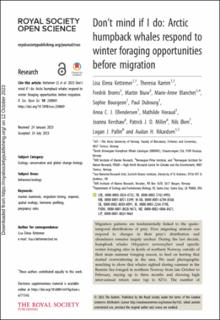| dc.contributor.author | Kettemer, Lisa Elena | |
| dc.contributor.author | Ramm, Theresia | |
| dc.contributor.author | Broms, Fredrik Björn | |
| dc.contributor.author | Biuw, Martin | |
| dc.contributor.author | Blanchet, Marie-Anne | |
| dc.contributor.author | Bourgeon, Sophie | |
| dc.contributor.author | Dubourg, Paul | |
| dc.contributor.author | Ellendersen, Anna C. J. | |
| dc.contributor.author | Horaud, Mathilde | |
| dc.contributor.author | Kershaw, Joanna | |
| dc.contributor.author | Miller, Patrick J. O. | |
| dc.contributor.author | Øien, Nils Inge | |
| dc.contributor.author | Pallin, Logan J. | |
| dc.contributor.author | Rikardsen, Audun H. | |
| dc.date.accessioned | 2023-10-17T09:24:51Z | |
| dc.date.available | 2023-10-17T09:24:51Z | |
| dc.date.created | 2023-10-05T14:03:58Z | |
| dc.date.issued | 2023 | |
| dc.identifier.citation | Royal Society Open Science. 2023, 10 (9), . | en_US |
| dc.identifier.issn | 2054-5703 | |
| dc.identifier.uri | https://hdl.handle.net/11250/3096928 | |
| dc.description.abstract | Migration patterns are fundamentally linked to the spatio-temporal distributions of prey. How migrating animals can respond to changes in their prey's distribution and abundance remains largely unclear. During the last decade, humpback whales (Megaptera novaeangliae) used specific winter foraging sites in fjords of northern Norway, outside of their main summer foraging season, to feed on herring that started overwintering in the area. We used photographic matching to show that whales sighted during summer in the Barents Sea foraged in northern Norway from late October to February, staying up to three months and showing high inter-annual return rates (up to 82%). The number of identified whales in northern Norway totalled 866 individuals by 2019. Genetic sexing and hormone profiling in both areas demonstrate a female bias in northern Norway and suggest higher proportions of pregnancy in northern Norway. This may indicate that the fjord-based winter feeding is important for pregnant females before migration. Our results suggest that humpback whales can respond to foraging opportunities along their migration pathways, in some cases by continuing their feeding season well into winter. This provides an important reminder to implement dynamic ecosystem management that can account for changes in the spatio-temporal distribution of migrating marine mammals. | en_US |
| dc.language.iso | eng | en_US |
| dc.title | Don't mind if I do: Arctic humpback whales respond to winter foraging opportunities before migration | en_US |
| dc.title.alternative | Don't mind if I do: Arctic humpback whales respond to winter foraging opportunities before migration | en_US |
| dc.type | Peer reviewed | en_US |
| dc.type | Journal article | en_US |
| dc.description.version | publishedVersion | en_US |
| dc.source.pagenumber | 0 | en_US |
| dc.source.volume | 10 | en_US |
| dc.source.journal | Royal Society Open Science | en_US |
| dc.source.issue | 9 | en_US |
| dc.identifier.doi | 10.1098/rsos.230069 | |
| dc.identifier.cristin | 2182092 | |
| cristin.ispublished | true | |
| cristin.fulltext | original | |
| cristin.qualitycode | 1 | |
